
Derivatives are a vital tool for managing and mitigating risk. They offer investors the ability to capture different types of opportunities than are possible in normal spot markets.
But their modern use only came to fruition in the last four decades.
Everything is happening again
Derivatives trades have been a part of markets ever since markets existed. History records that as long ago as 8000 BC, Sumarian traders inscribed clay tablets with proto-futures contracts [1]. In 1754 BC, derivatives trades as we might recognise them today - entering into contracts for future delivery - appeared in the Babylonian legal text which outlines ancient commercial law, the Code of Hammurabi [2].
Antiquity aside, the first recognised trade creating the OTC derivatives market we know and love today occurred in 1981: a currency swap agreement between IBM (NYSE:IBM) and the World Bank [3].
The derivatives market has since grown rapidly to reach a gross market value of $12.4 trillion as of December 2021 [4].
It took over a century of global gold exploration before gold futures were launched [5] on the COMEX exchange in New York. The impact on price discovery and market efficiency was near-immediate.
And it would take just short of four hundred years after the first company stock was bought and sold on the world's first stock exchange in Amsterdam for equities derivatives volume to overtake spot volume [6]. Economist Eli Renmolona for the St Louis Federal Reserve recounted the news in a breathless 1992 paper [7] that:
The stock of financial derivatives outstanding worldwide, as measured by open interest and notional principal, multiplied fivefold in five years to approach $10 trillion.
The same thing to happen to equities and commodities is now happening in crypto, only orders of magnitude faster.
The first crypto derivatives arrived in 2016 when crypto-native exchange BitMEX launched perpetual Bitcoin futures. This was just seven years after Bitcoin's debut on the world stage.
In December 2017, the first recognisable Bitcoin futures contract on a regulated exchange launched, on the largely US-traded Chicago Mercantile Exchange (CME).
Less than four years on from there, trading and capital volume in crypto derivatives overtook that of spot markets.
In response to soaring demand, Europe's Eurex followed [8] with their own futures product in September 2021, which is based on ETC Group's Bitcoin ETP (BTCE).
The landmark October 2021 launch [9] of a Bitcoin futures ETF in the United States only added fuel to the fire.
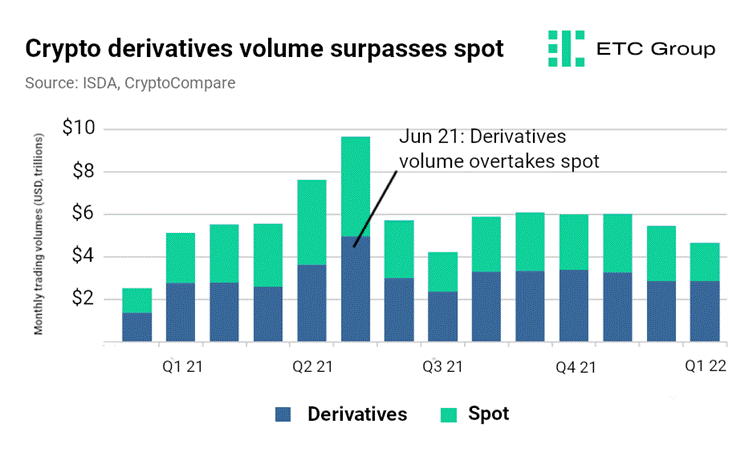
The main driver behind the shift has been the dramatic increase in institutional participation in crypto markets.
"Institutional capital allocations to crypto derivatives have accelerated rapidly in the last few years," said ETC Group co-CEO Bradley Duke. "And while spot markets used to be the key component in determining asset pricing, we are now seeing derivatives take a larger element of that role."
Markets have witnessed an almost eight-fold increase in global trading volumes [10] in digital asset derivatives since June 2019. Institutional data provider CryptoCompare noted that in June 2021 trading volumes in crypto derivatives across all trading venues amounted to $3.2 trillion. This surpassed spot transactions, reaching a 53.8% total market share.
That share is continuing to grow over time. As of January 2022, derivatives accounted for 60% of the total trading volume in cryptoassets [11] .
As the International Swaps and Derivatives Association noted [12] in December 2021's ‘Developing Contractual Standards for Crypto Derivatives':
The institutional adoption of digital assets is leading more companies to seek ways to hedge the risk associated with the volatility in digital asset prices.
The launch of Bitcoin futures products on regulated venues like the CME and Eurex “represents a significant step forward in this respect”, it said.
Demand first
The key force driving derivatives growth in any market is always client demand. Supply plays a role, of course: growth in advanced telecoms and market infrastructure, the development of option pricing and simulation models. But without the traders and investors to use them, interest in derivatives contracts tends to wither and die on the vine.
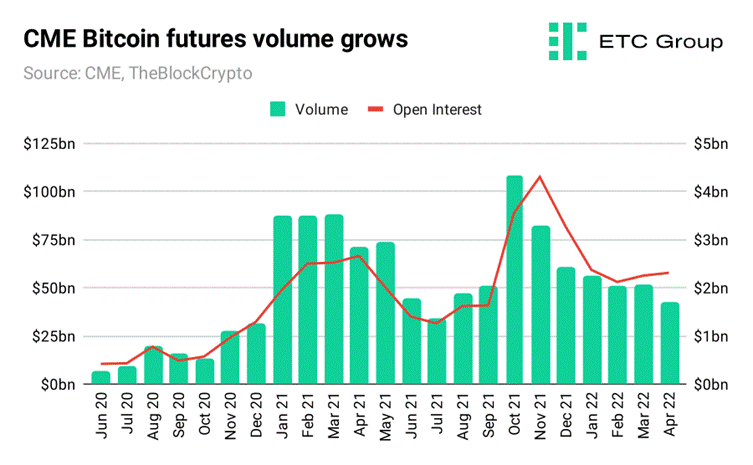
Even while Bitcoin volatility declined substantially across 2021 and early 2022 [13], derivatives trading volume has remained steady, at around $3 trillion per month.
In general, higher levels of volatility lend themselves to larger amounts of derivatives volume.
Repeat academic [14] and capital markets studies have shown that when futures markets become available, investors are better able to hedge spot price risk, and hence are more willing to take on larger spot positions.
Crypto volatility spiked in May 2022 with the crash of the Terra LUNA algorithmic stablecoin, whose demise sparked a market-wide crash wiping $600bn from the total market cap.
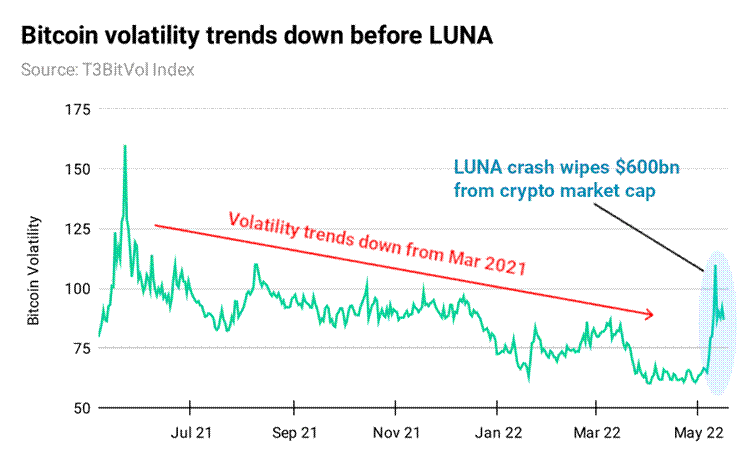
Indexing firm T3 produces the BitVol index as a measure of expected 30-day implied volatility in Bitcoin.
Being able to hedge downside risks and take advantage of arbitrage opportunities in crypto - which offer a profit from price mismatches or inefficiencies on different trading venues - are two of the key ways that institutions and traders use Bitcoin futures.
Cash and carry
Traders are constantly seeking the lowest-risk trades with Bitcoin, and arbitrage trades are among the simplest. As such, so-called ‘cash and carry' trades have become an exceptionally popular way to utilise Bitcoin futures.
Cash and carry is an arbitrage trade that combines the purchase of a long (buy) Bitcoin position in the spot market and a short (sell) of a Bitcoin position in a futures contract. Analysis shows that traders have increasingly been using the exchange-traded products like ETC Group's BTCE as the long leg of this trade, instead of spot Bitcoin itself.
BTCE is a structured investment product that is fully fungible 1:1 with underlying Bitcoin, and trades on regulated exchanges, so it affords traders that extra step of security that they can't get from Bitcoin alone.
How the cash and carry trade works
The trade takes place on the futures market, which means there is no direct funding fee.
Funding fees are periodic payments to traders that are long or short the particular crypto they're dealing with, depending on the difference between futures markets and spot prices. Depending on open positions, traders will either pay or receive funding.
Instead of a funding fee, there is an expiration date of some time in the future. When expiration happens, all positions, both long and short, are settled and cash is distributed one way or the other. The further out from today the expiration is, the larger the price difference with the primary (spot) market there will be.
If traders are generally bullish about the future of a particular crypto, the price will be higher, as they believe people will pay relatively more in future for that asset. If they are bearish, the price will be lower, as they think people will pay relatively less in future.
Contango vs Backwardation
Investors may come across two relatively obscure terms relating to futures contracts when they read about this subject: contango and backwardation. The former means that futures prices for a particular asset like Bitcoin are higher than spot prices. The latter means the opposite.
ETF managers have to roll over contracts each month, selling lower-priced contracts that expire in the current month and buying up higher-valued contracts for the next month.
So if ETF managers have to roll over futures regularly, what they will find is that when they're rolling, for example, November 2022 into December 2022, the curve is in contango. So rolling into a more expensive futures contract is going to cost them.
The cost of rolling on an ongoing basis means managers may have a ‘carry' cost as high as 5%, 10% or 20% dragging on their returns.
In response, they short sell futures to take advantage of this situation, so they are receiving the funding cost, not paying it.
The more than an asset is in contango, the more a futures strategy will underperform the spot price of an asset that such an investment vehicle is supposed to track.
Bitcoin has been in a state of contago 58% of the time throughout its history, according to analysis [15] by Jodie Gunzberg, Coindesk's Indexes Managing Director.
In an interview with CNBC [16] in October 2021, the former Morgan Stanley wealth management chief investment strategist noted that if investors had held shares in a Bitcoin futures fund rolled over every month for 12 months, they would have had to pay a cumulative cost 28% higher than the spot market price.
Who else uses crypto futures?
The market personalities using crypto futures have largely shifted from active traders to crypto corporates and institutions, as evidenced by the rapid scale-up in volume over recent years.
Take for example, Bitcoin miners. Publicly-traded companies like Marathon Digital (NASDAQ:MARA) are among the most bullish players on the future direction of Bitcoin.
Some hold many thousands of Bitcoin. Marathon is the world's largest public Bitcoin miner by assets held, with ₿9,673 [17] .
Even with the spot price of Bitcoin at a 2022 low of $30,000 at time of writing, this represents a healthy $290m on Marathon's balance sheet.

As one of the main trading personae dealing in Bitcoin futures, miners could be said to be akin to the commercial grower of corn or wheat. There are certainly obvious parallels to equity or commodity futures traders.
Miners, like growers, need to hedge downside risk while protecting their long positions; they likely have digital spot positions they may not want to liquidate in the event of a price fall in their underlying assets. They may also need to monetise their portfolio.
It's certainly easier to short crypto with futures contracts than to go out into the market and locate the physical underlying asset. That's true across commodities, whether a trader needs to hedge positions in energy and gas, crypto, lumber, oil or coffee.
The use of margin is helpful for corporates to manage cashflows: buying Bitcoin on spot exchanges requires traders to put down the full value of a trade.
With futures, corporates only need to put down a fraction of the cost, laying out a small margin and paying their variation margin on a day-to-day basis. The cost burden is taken away from the corporate and instead sits with the broker or futures merchant who manages that relationship.
The term structure of futures contracts are also particularly convenient for these types of market personalities.
Eurex Bitcoin ETN futures currently trade out to September 2022.
For a Bitcoin miner, that could be incredibly useful. That could help inform them how much they need to mine today, or tell them how much they should be investing in capex, for hiring new staff, purchasing new servers or ASIC mining machines. And it's knowledge they can lock in to inform their business processes today.
The next billion users
Crypto-native companies seeking the next billion users and traders are repositioning their offering to capture this upswell in interest in crypto futures and derivatives, and are delving ever more into regulated markets.
US exchange Crypto.com acquired two retail derivatives firms in December 2021 for a reported $216m [18], while Coinbase (NASDAQ:COIN) agreed a terms-undisclosed deal [19] to buy retail-focused derivatives platform FairX in January 2022.
"We think the US-listed derivative market presents a very substantial commercial opportunity" – Brett Tejpaul, head of Coinbase Institutional told Bloomberg.
FTX US also completed its takeover of LedgerX late last year [20], and the CBOE's acquisition of CFTC-registered ErisX completed in May 2022 [21] to the same effect.
Europe's retail-focused and largely unregulated cryptoexchanges have so far failed to capture the same zeitgeist. Europe's leading derivatives venue, Eurex, however, is at the forefront of the switch up.
Eurex board member Randolf Roth said [22] ahead of the launch of its Bitcoin ETN Futures that the derivative product was the “logical extension” of ETC Group's BTCE, one of the world's most liquid Bitcoin exchange traded products.
The new Bitcoin ETN futures enable investors to trade and hedge Bitcoin within Eurex's proven trading and clearing infrastructure without the need to turn to unregulated crypto venues or set up a separate infrastructure, such as a crypto wallet.
This tried and tested architecture apes the structure of all the other types of futures contracts that banks and asset managers are used to dealing with. So it makes the situation simple for those seeking to manage their crypto exposure and risk to get what they need, when they need it.
It is this ease of use: following the rules of the road that already apply to the broad suite of products asset managers are used to trading (equity futures, interest rate swaps, money market futures or dividend futures) that has seen interest and volume soar in this nascent financial instrument.
Indeed, Payal Shah, the director of equity and cryptocurrency products at CME Group outlined the scale of this explosive growth in a February 2022 interview [23] .
For Bitcoin, the growth has been phenomenal. When we launched in 2017 we were doing about 1,000 contracts a day. Fast forward to now, we're doing 10,000 a day. In the [micro futures contracts] we're doing 30,000 contracts a day. It's a sizeable market we're seeing.
The other key metric we monitor is large Open Interest holders. From an institutional perspective, a large Open Interest holder is any institution that holds in excess of 25 contracts. We're seeing for Bitcoin in excess of 100 large holders; 100 large firms holding that level of investment in Bitcoin futures contracts.
Europe embraces Bitcoin futures
The direction of travel is quite clear. Even as crypto markets cratered from their all time high prices registered in November 2021, Eurex Bitcoin ETN Futures saw substantial growth - both in terms of the number of contracts traded and in capital volume.
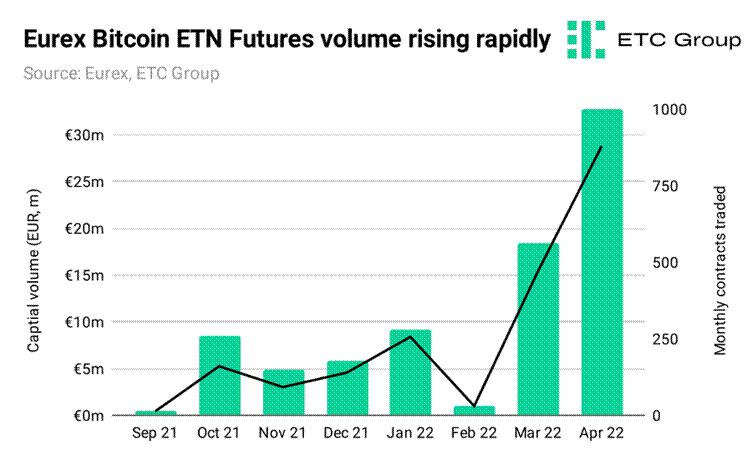
€19.7m of Bitcoin futures contracts changed hands on Eurex in the four months to the end of December 2021.
In the first four months of 2022, trading volumes are already three times higher, at €61.2m.
In terms of the number of contracts traded, Eurex has witnessed an average monthly growth rate of 381%.
And while just 13 futures contracts were traded in September 2021, by December 2021 the number was 10 times larger, at 139.
By March 2022 the figure had tripled to 470 contracts, and by April 2022 had more than doubled again to reach an all-time record of 879.
While European volume currently lags behind the United States, research has evidenced that Europe is the world's largest [24] global market for crypto. And futures on this side of the pond only appeared six months ago. If European futures volume follows that of the US, it could easily comprise a trillion dollars worth of trading volume by 2025.
More sophisticated, less complex
The types of derivatives contracts seen in the crypto market has now grown far beyond futures to other recognisable products including options and interest rate swaps. Fintechs and banks continue to expand their product offering to allow clearing for customer derivatives trades in futures, and cash-settled Bitcoin and Ether contracts.
And the benefits of trading futures crypto on regulated marketplaces have started to become clear. They are the seller for every buyer and vice versa.
They have standard checks and balances in place so investors don't suffer the kind of auto-liquidation that occurs on unregulated exchanges when markets move egregiously to the upside or downside. These are the kinds of tried and tested approaches with recognisable rules that are bringing institutions and active traders into Bitcoin in Europe.
"The introduction of Bitcoin ETN futures marks the first step in the Eurex portfolio of cryptocurrencies" says a release [25] accompanying its launch. This implies that as markets mature and grow, Eurex is ready to introduce more products.
That has certainly been the trend in futures and derivatives markets more generally. More choice, and more instruments to scale up supply to meet demand.
Six months after launching its own Bitcoin futures product, CME Group added Ether futures [26], and four months later, following booming client demand, added micro 1/10th versions of each product [27] to allow traders more precision in their positioning.
The future of futures
There remains ample volume and interest for TradFi exchanges to target going forward.
According to recent data [28], CME Group accounts for 1.05% of the $30bn Bitcoin futures market with around $311m of daily trading volume. Binance leads with 52% market share and around $15.5bn of daily trading volume. The vast majority of volume and open interest, some 97% of the market as of 18 May 2022, is still collected on unregulated exchanges.
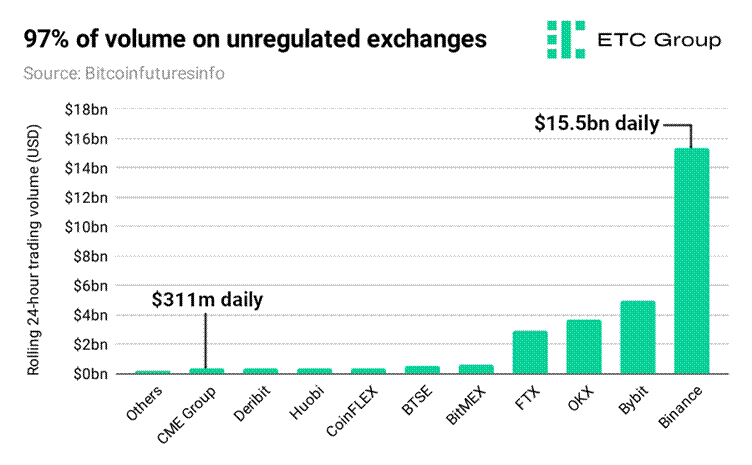
Figures represent rolling 24-hour notional trading volume in US dollars.
As markets mature, with regulations expected in 2022 in the US and UK, it is more likely that traders will seek the relative safety and security of a regulated entity like CME Group or Eurex. Here, at the very least, traders and institutions do not face auto-liquidations when markets move against their positions.
Outlook
The cryptocurrency derivatives market continues to grow, making up a bigger share of the overall crypto market. While it took some 400 years for equities derivatives volume to surpass spot volume, it took just 12 years for the same to happen in crypto.
As markets mature, becoming more sophisticated, and the number of new investors accelerates, it is highly likely to continue along this path. With the ramp up in high-end technology, the pace of change could easily outpace what market analysts have already seen.
Certainly the crypto standard of trading 24 hours a day, seven days a week has already made waves in markets globally.
Some proposed upgrades are more controversial than others.
For example, crypotexchange FTX plans to sell leveraged crypto derivatives to retail investors in the United States, but instead of involving financial brokers, wants to settle trades directly with traders [29] .
The US regulator, the Commodity Futures Trading Commission, is currently reviewing [30] this option.
With more regulation incoming from the world's major financial powers, trading futures on unregulated exchanges is likely to become less desirable than it ever has been before.
More comprehensive and clearer regulation is always to the net benefit of emerging and nascent markets. As the saying goes: regulation is a feature, not a bug.
Notes
Important information:
This article does not constitute investment advice, nor does it constitute an offer or solicitation to buy financial products. This article is for general informational purposes only, and there is no explicit or implicit assurance or guarantee regarding the fairness, accuracy, completeness, or correctness of this article or the opinions contained therein. It is advised not to rely on the fairness, accuracy, completeness, or correctness of this article or the opinions contained therein. Please note that this article is neither investment advice nor an offer or solicitation to acquire financial products or cryptocurrencies.
Before investing in crypto ETPs, potentional investors should consider the following:
Potential investors should seek independent advice and consider relevant information contained in the base prospectus and the final terms for the ETPs, especially the risk factors mentioned therein. The invested capital is at risk, and losses up to the amount invested are possible. The product is subject to inherent counterparty risk with respect to the issuer of the ETPs and may incur losses up to a total loss if the issuer fails to fulfill its contractual obligations. The legal structure of ETPs is equivalent to that of a debt security. ETPs are treated like other securities.
About ETC Group
ETC Group has been created to provide investors with the tools to access the investment opportunities of the digital assets' and blockchain ecosystem. The company develops innovative digital asset-backed securities including ETC Group Physical Bitcoin (BTCE) and ETC Group Physical Ethereum (ZETH) which are listed on European exchanges including XETRA, Euronext, SIX, AQUIS UK and Wiener Börse.
With a track record of over three years, ETC Group is made up of an exceptional team of financial services professionals and entrepreneurs with experience spanning both digital assets and regulated markets. With product quality and safety at the core of our product creation approach, the company aims to continuously launch best-in-class institutional-grade exchange traded products.
As a company, ETC Group has previously launched BTCE - the world’s first centrally cleared Bitcoin exchange traded product on Deutsche Börse XETRA, the largest ETF trading venue in Europe, and also listed DA20, the world’s first crypto ETP tracking an MSCI index signalling a move towards investment management products. DA20 provides broad market exposure to investors by tracking an index of 20 cryptocurrencies which cover 85% of the total crypto market capitalisation.


